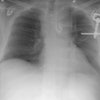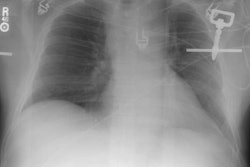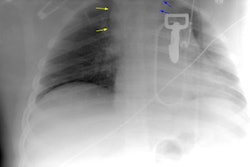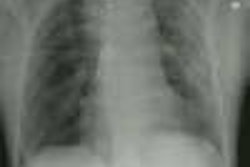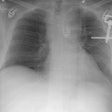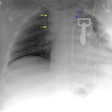Tracheobronchial disruption:
Clinical:
Disruption of the tracheobronchial tree is an uncommon, but
serious
complication of
blunt chest trauma. It is estimated that 30-80% of patients with
tracheobronchial injuries die before arrival at the emergency
department [8]. Following high velocity decelerating trauma about
1.5-3% of patients
will be found to have a bronchial fracture. The usual site of
injury is
within 2.5 cm of
the carina and the right sided bronchial injuries are slightly
more
common [5]. The mainstem
bronchi are injured much more frequently (80-85%) than the trachea
(15-27%), or peripheral
bronchi (5%). Bronchial lacerations are typically parallel to the
cartilage rings of the bronchi [6]. Tracheal lacerations are
usually
vertical and longitudinal and located at the junction of the
cartilagenous and membranous portions of the trachea [6].
Other causes of tracheal injury/rupture include iatrogenic overinflation of an ETT balloon cuff [7]. Overinflation of the balloon to 1.5 times the diameter of the normal trachea has been shown to cause tracheal injury [7]. An ETT-related tracheal rupture usually invovles the membranous posterior wall typically within 7 cm of the carina [7].
Over 30% of bronchial fractures are missed initially and 50% are detected on a delayed basis. First rib fracture is a marker of severe chest trauma and is found in up to 90% of patients with a bronchial tear. Other upper thoracic fractures are also commonly found (clavicle, sternum, scapula) [3]. Other associated major injuries include esophageal rupture in up to 20% of patients [5]. About 80% of affected patients die within 2 hours from associated injuries, tension pneumothorax, or respiratory insufficiency [5,6].
X-ray:
Conventional CXR shows pneomediastinum in 60% of patients and pneumothorax in up to 70% of injuries [5]. Findings suggestive of bronchial rupture include a persistent pneumothorax despite chest tube drainage. If there is complete transection of the bronchus, one may see the "falling lung sign of Kumpe" in which the collapsed lung on the involved side sags away from the hilus towards the diaphragm (in other causes of pneumothorax the lung collapses towards the hilum). On CT imaging, the affected lung will fall posteriorly [6]. Bronchial discontinuity may be identified by helical CT. Incomplete tears may be missed initially (about 10% of patients will have no radiographic or physical evidence of a tracheobronchial injury) and are detected in a delayed fashion when atelectasis develops distal to the site of airway stenosis with healing. If the parietal pleura is intact and the rupture occurs in the mediastinum, pneumomediastinum may be the only indicator of a bronchial injury.
Herniation of the endotracheal balloon outside the tracheal wall or balloon deformities are plain film indicators of tracheal injury [4].
REFERENCES:
(1) J Thorac Imag 1995; The bronchi: an imaging perspective. 10(4), 236-254 (239-241)
(2) Semin Ultrasound CT MR 1996 Apr;17(2):114-118
(3) Radiographics 1998; Kuhlman JE, et al. Radiographic and CT findings of blunt chest trauma: Aortic injuries and looking beyond them. 18: 1085-1106
(4) AJR 2001; Chen JD, et al. Using CT to diagnose tracheal rupture. 176: 1273-1280
(5) AJR 2003; Karmy-Jones R, et al. CT of blunt tracheal rupture. 180: 1670
(6) Radiographics 2008; Kaewlai R, et al. Multidetector CT of
blunt
thoracic trauma. 28: 1555-1570
(7) AJR 2012; Godoy MCB, et al. Chest radiography in the ICU part
I,
evaluation of airway, enteric, and pleural tubes. 198: 563-571
(8) Radiographics 2020; Moser JB, et al. Imaging evaluation of
tracheobronchial injuries. 40: 515-528
